Cryptid Long-Tailed Wildcats
Posted by: Loren Coleman on June 10th, 2008

The “Long-Tailed Wildcat” trapped and killed on January 16, 1922, in the Tinicum Swamp, Pennsylvania. Archival photograph, Henry W. Shoemaker, via Chad Arment.
Perhaps it would be good to take a bit of a look at the reports of long-tailed spotted and striped small mystery and not-so-mysterious cats, in light of yesterday’s mention of “Long-Tailed Bobcats.”
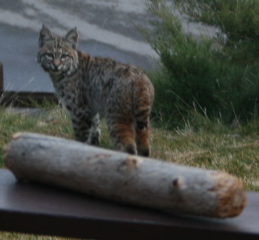
The bobcat pictured above has a short tail, but the photo shows how an allusion is created by the image of the tail merging with a back leg.
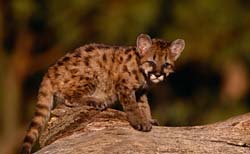
Puma, young.

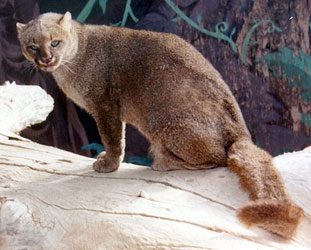
Are there any jaguarundis (Puma yaguarondi) in the mix?
Cryptozoologist Chad Arment has reminded me that the traditions, reports, and records of “Long-Tailed Wildcats” and “Long-tailed Bobcats,” especially in his native Pennsylvania, are elements of the cryptozoological research issuing from that state. These cats are often conceptualized in the literature in terms of being a cat identified as quite similar to the European wildcat or a feral domestic cat reverted to the wild-type mackeral tabby markings more than “long-tailed bobcats.” Arment has done a great job of tracking, collecting, and republishing these archives and reports in recent years.
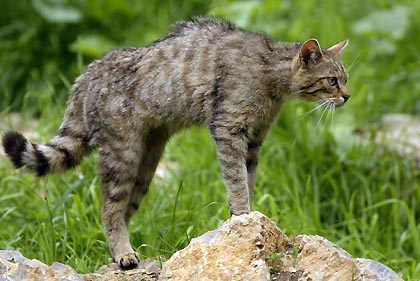
The European wildcat, Felis silvestris silvestris, above and below.

Arment’s book Cryptozoology: Science and Speculation (Coachwhip, 2004) has devoted an entire chapter, nine, to the issue, “Long-Tailed Wildcats.” Reproduced there, especially, are the observations of folklorist and wild animal story collector Henry W. Shoemaker. Shoemaker personally felt the felids being found, as described, in Pennsylvania, were examples of a unverified population of “Felis catus” or wild type of cat not dissimilar to the Scottish and European wildcats (Felis silvestris silvestris), which lived alongside puma and bobcat in his state, certainly in bygone days.

Arment has published online, as well, from BioFortean Review, (November 2006, No. 1), his “An Additional Account of an Alleged ‘Long-tailed Wild Cat'” about a newer case of a “wild cat” killed in 1966, near Grafton, Ohio.
Meanwhille, from the western USA, to add a bit of confusion to the picture, comes the stories and the “legendary” status of a new breed of domestic cat called the “Pixie-Bob”:
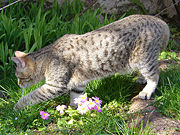
The Pixie-Bob (above) is a breed of cat claimed by breed founder Carol Ann Brewers to be a progeny of naturally occurring Bobcat hybrids . Later DNA testing failed to detect Bobcat marker genes and these cats are considered wholly domestic for the purposes of ownership, cat fancy registration, import and export.
In the spring of 1985 , Carol Ann Brewer purchased a polydactyl spotted male kitten from the base of Mount Baker (Washington State – Cascade Range). This male had a short tail like a Bob cat. In January of 1986 , she rescued another male cat. This cat was very large and had a bobcat tail. While this cat was starving, it still weighed 17 pounds, and was so tall it reached up to Brewer’s knees. Shortly after she had acquired this large male, it mated with a wild looking brown spotted female cat next door. In April of 1986 a litter was born from this mating. Brewer eventually kept one of the kitten, named “Pixie”, and after a year started a breeding program with Pixie as the foundation cat. Over the next couple of years, Brewer introduced into the program 23 cats from around the Cascade Mountains area that were believed to be born from naturally occurring matings between the Bobcat and domestic cat. She coined the term “Legend Cat” to refer to such cats.
The Pixie-bob was accepted into the “Exhibition” category by The International Cat Association (TICA) in 1993, promoted to “New Breed and Color” status in 1996 and eventually gained Championship status in 1998….
In 1996, DNA testing by Stormant Labs in California determined that Pixie-Bobs are genetically distinct and not related to other breeds. Wikipedia.
Great bewilderment can occur among the general public, in the realm of cryptid cats, and it’s not because there is a bit of “wild” in the middle of it all.
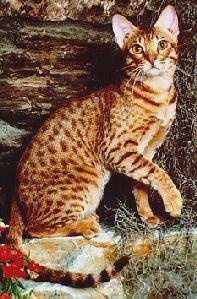
For example, a reported “wild ocelot (Leopardus pardalis) stalking a child in an American trailer park” turned out to be a pet Ocicat (pictured directly above and below), a breed with no wild genetic makeup at all. Despite its appearance, there is no “wild” DNA in the Ocicat’s gene pool. The species is actually a mixture of Siamese and Abyssinian, and later American Shorthairs (silver tabbies) that were added to the mix and gave the breed their silver color, bone structure and distinct markings.
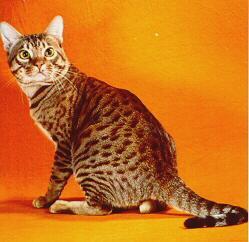
Phenotype is not always a reflection of genotype.
About Loren Coleman
Loren Coleman is one of the world’s leading cryptozoologists, some say “the” leading living cryptozoologist. Certainly, he is acknowledged as the current living American researcher and writer who has most popularized cryptozoology in the late 20th and early 21st centuries.
Starting his fieldwork and investigations in 1960, after traveling and trekking extensively in pursuit of cryptozoological mysteries, Coleman began writing to share his experiences in 1969. An honorary member of Ivan T. Sanderson’s Society for the Investigation of the Unexplained in the 1970s, Coleman has been bestowed with similar honorary memberships of the North Idaho College Cryptozoology Club in 1983, and in subsequent years, that of the British Columbia Scientific Cryptozoology Club, CryptoSafari International, and other international organizations. He was also a Life Member and Benefactor of the International Society of Cryptozoology (now-defunct).
Loren Coleman’s daily blog, as a member of the Cryptomundo Team, served as an ongoing avenue of communication for the ever-growing body of cryptozoo news from 2005 through 2013. He returned as an infrequent contributor beginning Halloween week of 2015.
Coleman is the founder in 2003, and current director of the International Cryptozoology Museum in Portland, Maine.










Pixie bob is a good bet. Although, you might be surprised what different breeds will actually mate as their numbers dwindle. After all, if we are wondering if they were puma cubs, what if they were puma/bobcat cubs? Would explain quite a bit.
Shumway10973: dunno about pumas and bobcats breeding. (Pumas are known to eat bobcats.)
But then, we don’t have quite the historical visibility with declining felid as with declining canid populations.
It pays to pay attention. Because what you don’t think happens at all could be happening, right now.
Pity that in the first 1922 photograph there is not a ruler or some scaling aid to determine the cat’s size.
There are in Pennsylvania Regular Bob cats with short tails and some with long tails not sure how they get that way but they are here. We also have a larger cat running about in the state that they say does not live here (ie) the Mountain Lion or a darn good clone of one. I have not seen one but have talked to folks who have. When I was a young man of 16, many years ago we went on a Critter hunt and I remember seeing tracks in the snow left by a big cat. Not dog or bear but a cat, but I forgot they don’t live here.
I sat with one that looks just like the first picture of the one that was skinned ….it had been hit by a car on RT 13 in Miliford NH 3 weeks ago, it was struggling to get across the streeet and I stopped the traffic and sat with it until the police came as it was expiring . the cop was going to shoot it because it was a sunday and no fish and game was on duty , but he finally found one willing to come out from Greenville NH , they where concerned if I had touched it , I did its neck that had a neclace of ticks around it , it felt like large fish scales .They can confirm that they are here , also I was told another was hit a week or so later near the same spot. It was short haired on the face as well as body and double the size of a house cat .
I love this subject. I think Kittenz perspective in the previous post on this subject a couple of days ago in which she speculates that cross breeding between wild bobcats and domestic shorthairs would be a reasonable expectation are on target and also, like her, would love to see the discover of a mystery feline somehow overlooked all this time due to its cryptic nature/behaviours.
It also brings to mind that by the time that a modern biological survey of the eastern woodlands had been undertaken, most of the land had been logged, hunted, trapped, fished, burned, drilled, mined, quarried, dammed, and overlain with roadbeds and railroad tracks. The likelihood of sparse populaton of some wildcat not recognized by the relatively unsophisticated (not to say inexperienced) people of the day, is an intrigueing one an dnot that hard to believe for me. We know for example that in the mid to late 1600’s (over one hundred years before Audobon made some of the first surveys) the landscape of the eastern woodland was vastly differnet from what we see today even in national parks and forests. I highly recommend reading Charles C. Mann’s “1491: new revelations of the americas before columbus” where he goes back to the original accounts to describe what the woodlands were like when they were dominated not by conifers like hemlock, whitepine, spruce and balsma fir, or deciduous trees like wild cherry, beach. maple, and oak as mostly seen today but with a wildly diverse mix of productive trees such as chestnut, walnut, hickory and paw paw which supported vast numbers of animals and birds, almost all of it under the distinctive form of loose cultivation as practiced by the native communities that lived throughout these forests in fairly great numbers prior to the introduction of European diseases and the subsequent de-population of the “prisitne wilderness”.
They don’t call the North American Lynx Rufus ‘wildcats’ for nothing. I’ve seen bobcats not just stand their ground but aggressively attack much larger dogs and I’ve also seen them bring down some fairly large whitetail does and immature bucks. From what I understand the Southern and Texas subspecies are much more aggressive than the those found in Northern climates. I’ve seen at least one film where a bobcat defended itself pretty well against a cougar. Most of the time they’ll run from humans and dogs but I know of at least 2 hunters who got more than they bargained when hunting them. My great uncle had the scars to prove it. He called them ‘gatos diablos’ which translates to devil cats. They were several attempts back in the ’70’s to crossbreed a domestic with a bobcat for a movie version of Allan W. Eckert’s, The Crossbreed but none of the kittens were tame as adults.
I’ve seen a long-tailed bobcat or what I call “werecat” screech and buzz around my back porch twice. It could be a domestic cat, but it had spots and stripes on it just like the photos.
This cat I saw was about three and a half feet from the head to end of tail with short hair on the face. I contacted fish and game from my state’s main office to have him follow up on what happened but have not heard back from him yet. It was much larger than a house cat, and it seemed to me to be very thin as well as the 3 inch necklace of ticks. It was wild for sure. I am in southern NH, and it was near death so I cannot attest to its character. I am not a pro, just a bystander.